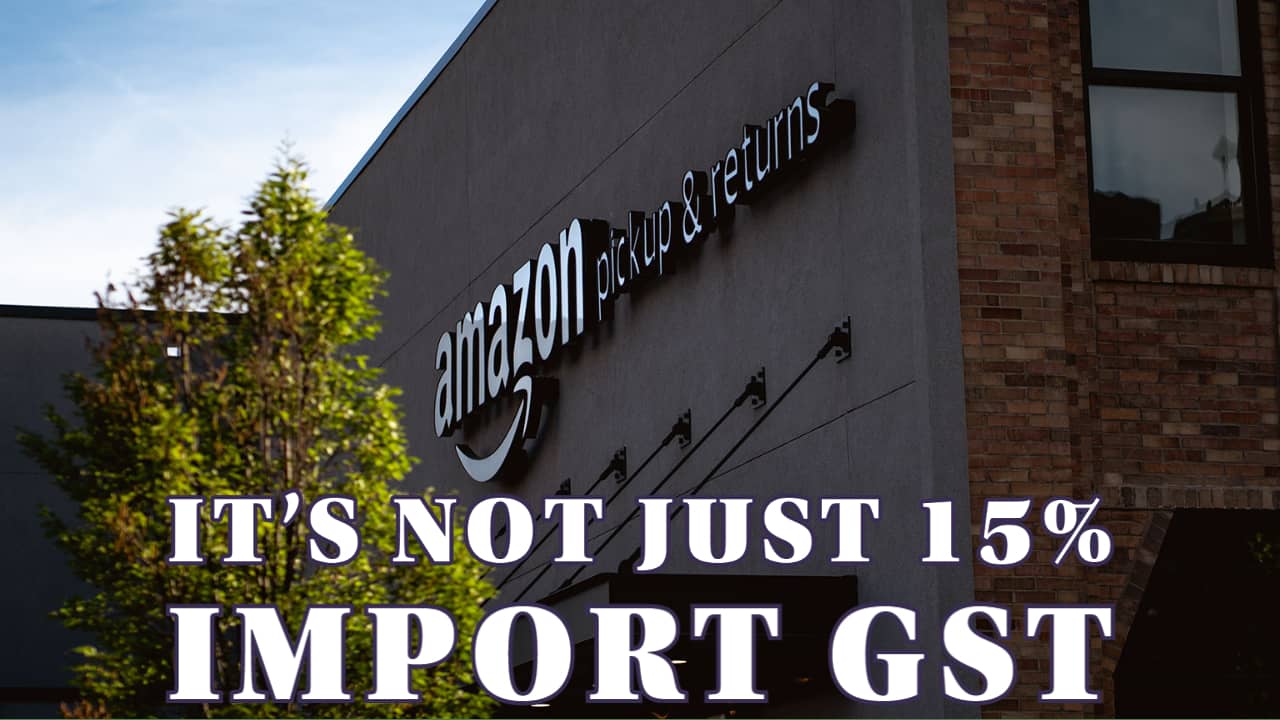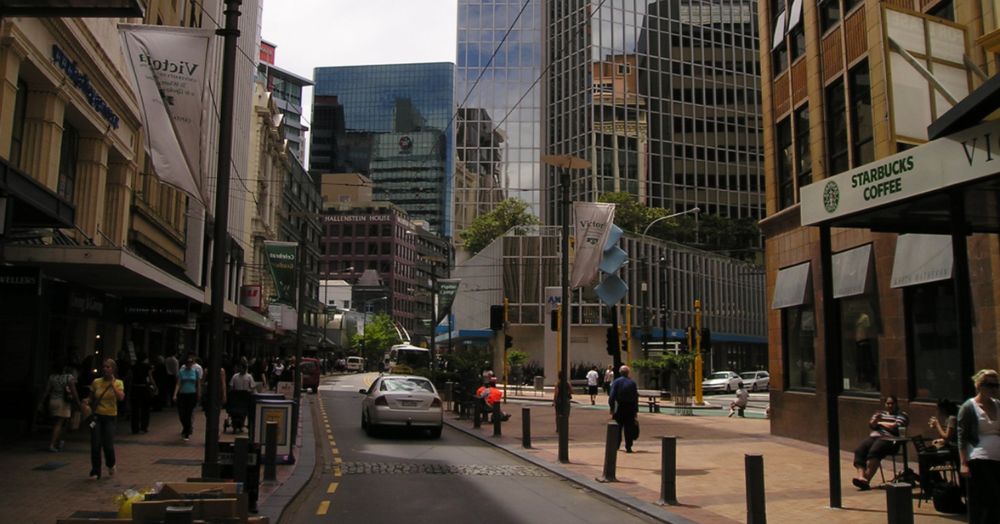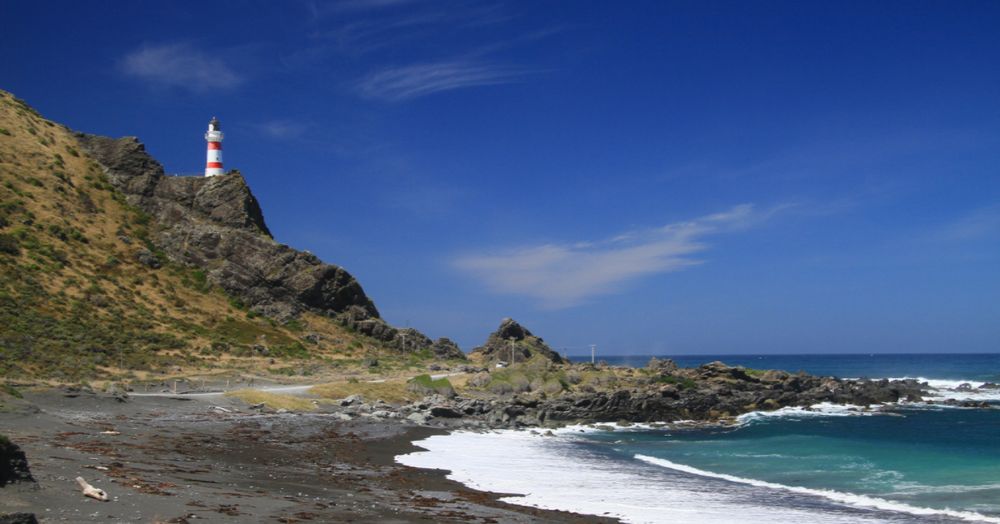
Amazon Tax: What You Need to Know & Beware of This Trap
17-minute read (11-minute watch)
You’ll learn:
- Who benefits from this new tax
- Current GST rules, how and when they are going to change
- How much you have to spend on customs clearance, including customs broker fee
- What you should be aware of in regards to Amazon Tax
Watch full YouTube episode below
Alex: Everyone keeps talking about Amazon Tax, it’s in every newspaper right now, lots of people got worried – ‘What does it mean for all of us?’
And we will explain how it works.
Max: And especially how it affects you.
Alex: My personal opinion – I’m still not sure is it good or is it bad.
Max: Come on! Why is it good if I’m spending more? Any tax is bad, right?
Alex: Supposedly, it’s going to be good for retail businesses, who will be able to now compete with overseas suppliers of cheap goods.
And of course, it’s going to be good for government because they get additional tax, and they will spend more money, which is a lame excuse to introduce a new tax.
#1. CURRENT TAXATION RULES
Alex: What it is now is as soon as you get $60 worth of tax, you will have to do a proper customs clearance to your goods, and it will include a number of things.
What they want to do – they want to introduce a new tax and put a new cap.
Max: Let’s be honest – it’s not a new tax, GST has been forever, right? They’re just going to calculate it differently.
Alex: At the moment, you don’t pay any tax on goods valued at or below $400.
#2. NEW RULES
Alex: From the 1st of October 2019, they want you to pay GST on the first $400 worth of your goods.
To make the things simpler – they would like to make it just a value-based one, $400.
Before you had to use the calculator and try to figure out, what’s going to be your tax, what’s going to be your freight, what’s going to be your customs broker’s fee , different exchange rates.
Now, you’re going to be just buying things on the spot, say, Amazon – that’s why it’s called Amazon Tax – and any other significant supplier, big Internet platform like – tell them, which are they?
Max: AliExpress, eBay or any other website.
Alex: And that supplier will charge you on the spot. For example, if you’re buying something worth $300 or $200, they will charge you 15%, and you will pay on the spot all these money.
And then your goods are shipped to New Zealand, and then you get them freely, without any customs clearances whatsoever.
But I have to say, if, for example, right now, say, you’re buying a pair of shoes worth 200 US dollars, if you add freight on it, they might be just over $400 in value or $60 in tax. So, you’ll have to do a proper customs clearance, right?
Max: Well, it’s not all $400, because if you convert it from US dollars to NZ dollars, it’s going to be less than $400, but because there is a duty, which nobody tells you about when you buy it …
Alex: And in total it’s going to be $60 worth of tax, then it means that you are required to do the customs clearance. Once you do that, you’re going to go to a customs broker, you’re going to spend money on him/her.
Max: It will cost you anywhere between $50 to $60 + gst.
Alex: And you have to pay to NZ customs another $50 for customs transaction fee. So, in total, your shoes will be worth not $200 that you have paid for them initially, but also those charges on top. So, you end up paying $500-$600 for a pair of shoes.
Max: Double your price for shoes.
Alex: So, it hurts, right? With a new law, you’re going to pay $200 (US) plus 15%. Period. Nothing else. Which actually makes the things better.
But for everything else you’ll have to pay more because before if there’s no duty if there’s no $60 worth of tax – no customs clearance, free to get your goods.

Max: Right, so it’s more straightforward, and you know upfront all your costs. That’s going to be the new rule, and the new law becomes valid on the 1st of October the next year, and you’ve got some time till 29th of June to voice your opinion if you don’t agree with that.
Alex: I don’t think it’s going to help.
Max: Well, yeah, chances are probably it’s going to be as it is right now, but still, we have an opportunity to send the email and disagree, or make some changes.
#3. THE TRAP
Max: Alright, so what’s the trap? The trap is if you buy the goods and if you buy it from Amazon – this big guy – and use a service called ‘YouShop’, you may be thinking that you paid $200 and all taxes were included.
Once it’s been delivered to their warehouse in the States, and then it’s been forwarded to New Zealand’s fee , it arrives here, and you are happily waiting for your goods to turn up at your doorstep, only to find out a week later in a big envelope that you’re going to get from New Zealand post that you have to pay something more.
Alex: Basically your goods have been stopped for customs clearance because they are more expensive than $400.
Max: And once again – nobody told you that. Even though it’s been processed by the seller overseas, this Amazon Tax doesn’t apply, because the seller didn’t know it’s going to go to New Zealand.
When the seller sold it to you, they thought it’s going to go from their Amazon warehouse to another house or another apartment in the States, so it’s not going to leave their country. That’s why you didn’t pay any tax on top.
But once it’s going to cross the border from the States to New Zealand, the customs system or New Zealand post system will pick it up.
And how much you’re going to pay? If you imported, say, $250 of shoes, you’re going to pay roughly $70 to a broker.
Alex: And again, $50 to customs.
Max: So, the customs transaction fee and the tax is another thing. So, initial $250 will turn up more.
#4. FOOD FOR THOUGHT
Alex: A couple of things to consider about the new law. Not every overseas company will be charging you the GST because it’s just impossible for New Zealand government to force this law to every possible oversea shop or online shop.
So, they only want to do it with the big guys like Amazon or AliExpress or eBay.
Max: If I’m going to shop online, how am I supposed to know am I liable for a tax or not? Am I going to have problems?
Alex: That’s a big question. They want to exclude overseas suppliers, which do sell the goods to New Zealand for less than $60,000 a year.
How are you supposed to know that, how much do they sell? Well, it’s going to be up to a supplier. If you see that the supplier charges you 15% of GST, make sure that you keep the receipt.
So, if customs do stop your goods on the border, at least you can show them this piece of paper and say – ‘Look, guys, they charged me 15%’. And hopefully, they will believe you and will let your goods GST free.
#5. SUMMARY
Max: I think, the main points: we just told you the current rules, we told you the new ones that will be effective next year 1st of October, and the trap that you have to be careful with when you use the service companies like “YouShop”.
There could be other similar companies that you may be liable for extra taxes once it arrives in New Zealand’s fee.
Alex: Interesting to know that they actually want to ditch all other charges. When you’re buying something for less than $400, it’s going to be only GST payment.
So, you don’t have to jump on the line and use your calculator to find out how much it’s going to cost you because now it’s very simple. There’s going to be no duty; there’s just the GST.
And for the goods which are more expensive than $400, everything stays the same, exactly how it is now.

Alex: Another proposal of them, they want to do it only for individuals, which is also really hard to understand because how they’re going to control whether it is the company or an individual that is buying something?
And it’s not uncommon that many things bought by directors of the company, and it looks like it’s an individual, but it turns out to be for the company.
And if you are the company that is importing some goods, you still have to go under all rules and do the proper customs clearance.
It’s a big question, and we hopefully will know by the end of this year or by the mid of the next year how it’s going to look like because there’s still a big question and the way it is now – it’s not perfect.
But the one thing is for sure, the one way or another we’ll have to pay that extra 15% on everything we buy from overseas.
Max: Thank you for your time. If you enjoyed this information, make sure you subscribe on YouTube , we appreciate it.
Stay tuned, we’re going to pick another interesting topic next week, and we’ll share with you some insider knowledge.
GST loophole closed to offshore companies
The Government is to close a loophole that gives offshore companies an advantage by not requiring them to collect GST on all goods sold to local consumers.
“Domestic businesses have long called for greater fairness in the treatment of low-value goods from offshore retailers,” says Revenue and Small Business Minister Stuart Nash. “Foreign companies are not required to collect GST on goods under $400. We are now calling for feedback on a system to register these suppliers for GST.”
“There are more than 26,000 small businesses employing more than 62,000 people in the retail sector. Many are in competition with foreign firms who enjoy this tax break. Local firms compete on an uneven playing field. Large multinationals sell exactly the same product into our market without collecting GST.
“Small businesses such as bookshops have convincingly argued they are penalised by a system which is badly out of date. It’s particularly difficult for very small shops outside the main centres. Some Kiwi firms are doubly disadvantaged, as online retailers who sell into Australia will soon pay GST to the Australian Tax Office,” Mr Nash says.
“GST has always been payable on low-value goods but it is not cost effective for Customs to collect it when it is $60 or less,” says Customs Minister Meka Whaitiri.
“GST is collected at the border for goods over $400. We propose making offshore suppliers collect GST on low-value goods at the moment of sale, and in turn, buyers of these goods will no longer pay Customs tariffs or border security and biosecurity fees. This will simplify compliance and administration costs at the border. This supports the focus of Customs to make cross-border transactions easier without compromising the need to keep out illicit substances and materials,” says Ms Whaitiri.
“GST has been collected on services and digital products from offshore, such as streamed movies and music, since 2016. This extends that to goods,” says Mr Nash.
“I thank the Tax Working Group for its advice to proceed with the proposal. It is consistent with our GST framework, which is broad-based, low-rate, and applies to goods and services traded across borders and consumed here,” Mr Nash says.
Submissions on the proposals are due by 29 June 2018. The discussion document can be found at: taxpolicy.ird.govt.nz .

Questions and Answers
1. What do other countries do?
Australia will have an offshore supplier registration model for collecting GST on low-value imported goods from 1 July 2018. Switzerland will also introduce an offshore supplier registration system for the collection of VAT on low-value goods from 1 January 2019.
The EU has announced plans to implement a system akin to an offshore supplier registration model for the collection of VAT by 2021. Other countries such as the United Kingdom and Canada also have a de minimis that is significantly lower than New Zealand’s de minimis – the threshold at which revenue is collected.
2. Why is this a priority?
It is a question of fairness. Smaller retailers, especially those who operate outside large shopping centres, struggle against foreign competitors who enjoy a tax advantage. New Zealand’s GST is a broad-based consumption tax with few exemptions.
It is based on the principle that goods and services are subject to GST when they are consumed in New Zealand. All domestic retailers have GST added to the price tag of their goods. The proposed measures will help to restore balance.
3. How much revenue is the proposal expected to collect?
The changes would take effect from 1 October 2019. Revenue officials conservatively estimate that $53 million would be collected in 2019/20, increasing to $78 million in 2020/21 and $87 million in 2021/22.
4. How will the proposed changes affect consumers?
GST will be charged at the point of sale when the value of the goods is $400 or less. In some cases, consumers will pay more for their goods but in some cases, goods will be cheaper because of the removal of Customs tariffs, border security fees and biosecurity cost recovery charges. There is no change to the tax treatment of goods valued above $400, where the current process for collecting GST and tariff duty at the border will continue.
5. Would all offshore businesses selling online to NZ be required to register for GST?
Offshore retailers would be required to register and collect GST if their total sales to New Zealand consumers exceed NZ$60,000 per annum. This is the same threshold that applies to domestic businesses and to offshore suppliers of cross-border services.
6. How much GST was collected from offshore sellers of services after the law changed on 1 October 2016?
Over 200 offshore suppliers registered for GST under the new rules on services. They have returned more than $162 million to New Zealand since 1 October 2016, well above initial estimates of $40 million per annum.
Fact sheet – GST on low-value imported goods
Summary of proposals in the discussion document
From 1 October 2019:
- Offshore suppliers would be required to register, collect, and return New Zealand GST on goods valued at or below $400 supplied to New Zealand consumers.
- The rules would apply when the good is outside New Zealand at the time of supply and is delivered to a New Zealand address.
- Offshore suppliers would be required to register when their total supplies of goods and services to New Zealand exceed $60,000 in a 12-month period. In certain circumstances, marketplaces and re-deliverers may also be required to register.
- Tariffs and border cost recovery charges would be removed from goods valued at or below $400.
- The current processes for collecting GST and other duty at the border by Customs will continue to apply for goods valued over $400.
- The current border processes for managing risks in relation to imported goods, including biosecurity assessment, will remain in place.
The following table sets out what the changes would generally mean for different parties:
| Buyers & sellers | Imported goods valued at or below $400 | Imported goods valued above $400 |
|---|---|---|
| NZ consumer | GST charged on the purchase at the point of sale. | GST collected on purchase at the border by Customs. |
| NZ GST-registered business | No GST charged on the purchase | GST collected on purchase at the border by Customs. Any GST incurred can be claimed back. |
| Offshore suppliers, online marketplaces and re-deliverers that reach the registration threshold | GST should be charged, collected and remitted to IRD on sales to NZ consumers. GST should not be charged on supplies made to GST-registered businesses. | GST should not be charged by the supplier. Customs would collect GST as the goods cross the border. |
Note: this table reflects only how the proposed rules would work in the majority of cases. Actual results may differ in some instances. Chapter 3 of the Discussion Document has a more thorough explanation of the scope of the proposals. For example, it addresses what would happen if an offshore supplier returns GST on a consignment that Customs assesses as having a value greater than $400, or if a GST-registered business is incorrectly charged GST by the supplier.
Impact on consumers – examples
The proposed changes would not necessarily mean that all online purchases of goods by consumers will become more expensive.
Under the proposals, if a consumer imports goods valued at or below $400 the offshore supplier would add GST to price of the online purchase. Goods valued below $400 which do not currently have GST, duties and cost-recovery charges collected at the border would be more expensive under the proposal.
However, goods valued at or below $400 which do currently have GST, duties and cost-recovery charges collected at the border would be cheaper under the proposal. [1] This is because consumers would no longer pay tariff duty and cost recovery charges on these goods.
| Purchase | Current treatment | Proposed treatment |
|---|---|---|
| $50 t-shirt | Total cost of parcel: $50 No current charges at the border | Total cost of parcel: $57.50 $50 t-shirt + $7.50 GST |
| $300 jacket | Total cost of parcel: $428.74 $300 jacket + $30 tariff (10% x $300) + $49.50 GST (15% x $330) + $49.24 border processing fee | Total cost of parcel: $345 $300 jacket + $45 GST. |
Proposed registration requirements for offshore suppliers
Offshore suppliers would be required to register and return GST if their total supplies in a 12-month period to New Zealand consumers exceed $60,000. This is the same threshold that applies to domestic businesses and to offshore suppliers of cross-border services. Offshore suppliers would not be required to collect GST on goods supplied to GST-registered businesses.
The proposal includes special rules for online marketplaces and “re-deliverers”:
- In situations where an offshore supplier sells their goods through a marketplace, the marketplace is required to register and return the GST on the good instead of the supplier.
- Re-deliverers are used by consumers when the supplier or marketplace does not offer shipping to New Zealand. The good is instead shipped to an overseas “hub” or mailbox, which then ships the good to New Zealand. Under the proposals, re-deliverers would be required to register and return GST in respect of goods that they “re-deliver” to a New Zealand address.
The $60,000 GST registration threshold would also apply to marketplaces and re-deliverers.
Where can I make a submission on the proposals?
To make a submission on these proposals, please e-mail policy.webmaster@ird.govt.nz or write to the following address, by 29 June 2018:
GST and low-value goods
C/- Deputy Commissioner Policy and Strategy
Inland Revenue Department
P O Box 2198
Wellington 6140
[1] The exceptions to this are alcohol and tobacco products. Excise taxes, GST and other charges would continue to be collected on these goods at the border by Customs, regardless of their value.
Tax Working Group letter advising ministers to proceed
GST on low-value imported goods
I am writing to you to provide the Tax Working Group’s (the Group’s) recommendations for collecting Goods and Services Tax (GST) on low-value goods imported into New Zealand.
You previously wrote asking the Group to consider this issue. In your letter, you noted that the Government is minded to proceed with this work, and would welcome early advice on the merits of reform options, ahead of the production of the Group’s Interim Report in September.
The Group has now considered this issue and agrees that in principle GST should be collected on low-value imported goods. Collecting GST on low-value imported goods is consistent with New Zealand’s broad-base low-rate GST framework. It is also consistent with New Zealand’s destination principle, which provides that GST should apply to goods and services that are traded across borders when they are consumed in New Zealand.
As a result, there is no in-principle reason why GST should not be collected on imported goods consumed in New Zealand just as it is collected on domestically sold goods consumed in New Zealand. The current non-collection of GST results in a competitive disadvantage and unfairness for New Zealand retailers and results in an increasing amount of GST revenue foregone for the Government.
The non-collection of GST is an increasing problem which the Group considers should be addressed quickly. The key question is how to collect GST on low-value imported goods in the current environment in a low-cost and effective way.

The Group has considered three options:
- Offshore supplier registration: Offshore suppliers would be required to return GST on low-value goods supplied to New Zealand consumers if their total supplies to New Zealand exceed the GST registration threshold.
- Between the point of sale and delivery: Freight couriers and New Zealand Post would collect revenue on low-value imported goods they deliver.
- Pay after delivery: Consumers would pay the GST on low-value imported goods after they have been delivered to them.
In the short term, of these three options, the Group prefers the option of an offshore supplier registration system. The Group considers that this option would provide a cost-effective way of collecting GST that would also provide price certainty and low compliance costs for consumers. The Group considers that currently there are practical concerns with options to collect between the point of sale and delivery and after delivery that mean they may not be feasible in the short term.
The two concerns with an offshore supplier registration system are potential non-compliance with the rules by offshore suppliers and the potential for not returning the revenue collected. Officials have advised us of the recent success of the application of this model for cross-border services and intangibles and so this provides an encouraging sign in this regard.
For this option to be successful, the Group considers that further consultation on the detail and implementation of an offshore-supplier registration model is essential. Further consultation is needed to ensure that this model is effective.
The Group has concerns that an offshore supplier registration model would mean that GST would continue to not be collected on imported low-value goods provided by unregistered sellers. For this reason, the Group would not support an increase in the threshold for collection of GST by Customs which is generally $400.
We note that the $400 threshold is equivalent to the current de minimis for goods that are not subject to tariffs. However, for goods that are subject to tariffs the $400 threshold would be a rise in the de minimis of up to $174. Officials have advised that setting the de minimis based on the value of the good is necessary to minimise compliance and administration costs for an offshore supplier registration system.
On the basis of this advice the Group accepts that the small rise in the threshold for goods sold by unregistered suppliers is broadly acceptable given the plan for offshore supplier registration is to include marketplaces and parcel forwarders. This will narrow the scale of non-registration.
Officials have advised that the impact of raising the de minimis will result in a small reduction in tariff revenue and Ministry for Primary Industries and Customs funding for border and biosecurity risk management. However, in their view the benefits of having a simpler threshold through reduced compliance and administration costs will outweigh the costs.
In addition, the Group recommends that the Government continue to review the options to collect GST between the point of sale and delivery and after delivery following implementation of an offshore supplier registration model. This continued review should consider whether the feasibility issues with these options can be overcome as technology and data sharing improvements occur.
As a result the Group recommends the following:
a) The Government should implement an offshore supplier registration model to collect GST on imported goods from suppliers who exceed the GST registration threshold.
b) The de minimis for collection of GST by Customs should be changed to a $400 threshold based on the good’s value but should not be increased beyond that point.
c) The Government should consult on the proposed offshore supplier registration model to ensure it is effective.
d) Options for collecting GST between the point of sale and delivery and for payment of GST after delivery should continue to be reviewed to see if the practical issues with them can be overcome and become an effective means of collecting GST on low-value goods, in particular from unregistered suppliers.
Source: Inland Revenue
We’d love to answer any of your questions! Contact us now
P.S. Do you know of other people that will find this article useful? Please share it on social media. Thank you!

